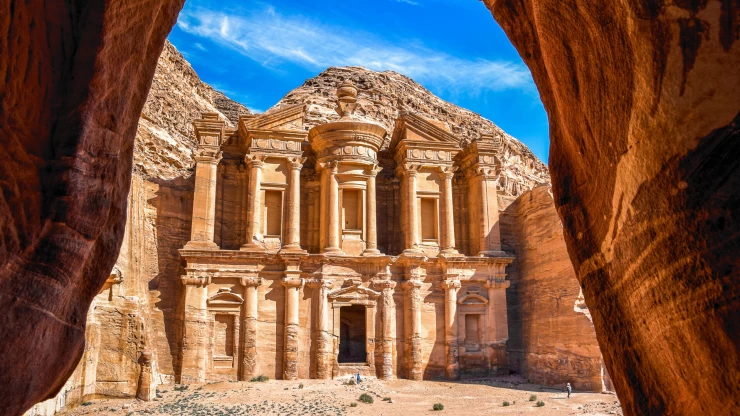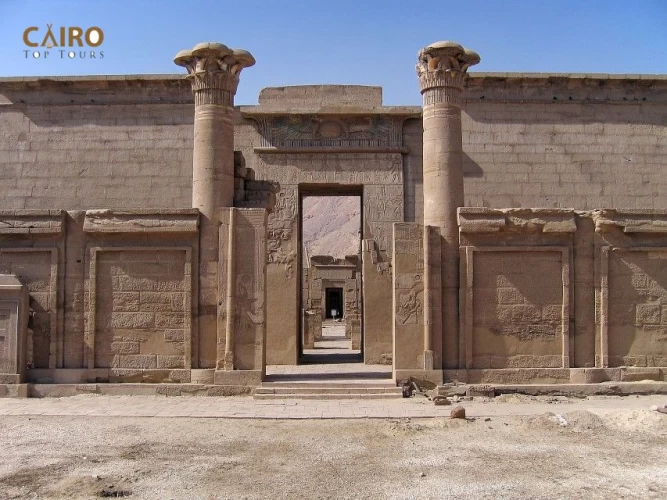
Temple of Madinet Habu
Madinet Habu
Built because of the seat of power by Queen Hatshepsut and Ramses III, one of the best pharaohs of Egypt throughout the new kingdom, Medinet Habu resembled a fortified town, with temples, palaces, chapels, and residential neighborhoods supposed for monks and officers.
Queen Hatshepsut | Queen of Egypt | The Pharaoh Woman
Throughout the invasions of Egypt within the 20th dynasty, the whole population of Thebes (Luxor nowadays) took refuge inside the huge walls of the Mortuary Temple of Ramses III.
Temple of Ramses III
You enter the temple through the fortified gate, a three-story building. On the higher floors was the king's non-public residence, embellished with scenes that portray him diverted by slender dancers. various military campaign area units recorded on the pylons and on the walls of the temple.
In the second court, you'll see painted reliefs portraying spiritual holidays, preserved because of the Christians who reworked the realm into a church within the early Christianity in Egypt and coated the pictures that were thought-about offensive to them with a layer of plaster.
Why was the temple built?
Ramses III built his funerary temple to record his victories on its walls and to serve as a temple to Amun, the god of war, Sekhmet, and Osiris. Sekhmet was represented as a woman carrying the head of a lioness to indicate strength and ferocity. The Habu area was particularly sacred to the ancient Egyptians, who believed that the eight gods of creation, according to Ashmounian doctrine, had traveled here, in this area on which the temple was built.
Luxor ِِِAttractions
You can go to a special place called the Temple of Deir Shelwit, and it will make you feel like you are in ancient Egypt. You can learn a lot about how great the ancient Egyptians were.
In the region of Luxor’s West Bank, the Temple of Medinet Habu can be found, which is one of the most interesting yet underrated temples in ancient Egypt. It is beautifully adorned with rich reliefs and towering structures in the center, as well as depicting splendid and realistic illustrations of life and religion in ancient Egypt. This temple is dedicated to one of the most prominent Pharaohs, Ramesses III, and offers a great deal of information regarding the King's reign, struggle, and accomplishments, which are visually inscribed all over the temple walls.
Historical Significance
Medinet Habu was not only a funerary temple dedicated to King Ramesses III but also a stronghold that fortified the area against aggressors. This temple, belonging to the 20th dynasty, was more than a place of worship because it also served as an office, a command center, and a fortress during an era of unrest. The high and beautifully carved walls and the soaring entrance gates—the pylons—of the king tell stories of his battles and conquests, giving the impression of the Pharaoh as a god rather than a king, with whom the gods were pleased with.
Architecture and Layout
What makes the Temple of Medinet Habu distinctive is its architectural style that combines elements of Egyptian houses of worship and those of fortresses. It can be said that the entrance to the complex is done through a mighty gate, which has walls characteristic of fortified walls and lets it serve the purpose of worshipping and of a refuge. Further past the outer walls, the visitors are welcomed by the grand entrance known as the First Pylon, which is beautifully engraved with the war escapades of the Pharaoh and provides access to a court with huge figures of Ramesses III.
Deeper within the temple, the Second Pylon opens up to a smaller court and a few pillared halls with beautifully painted ceilings. The hypostyle hall, another attraction of the interior, is filled with vividly painted columns depicting different gods, goddesses, and ritual practices, transporting tourists into the world of ancient Egyptians’ practices and beliefs.
Art and Reliefs
Medinet Habu stands out primarily for its strikingly intricate relief sculptures that speak volumes of the artistic and religious context of the period. In contrast to several other ancient buildings, the colors here are as intact as they were even after thousands of years. Elaborately carved scenes show Ramesses III at the height of battle, being blessed by some gods, and performing some rituals. One can see the two-dimensional works of art in such deep relief that one can see the curves of the individual ornamentation, the graphs of the elementary pattern of the narrative—faces, and even the interiors of those faces.
Additionally, there are among the most realistic illustrations of war in ancient Egypt, showing the conflicts between Egyptians and Sea Peoples, a powerful threat at the time. These images depict Ramesses III in a particularly glorious light, impressive in both his martial prowess and military genius.
Spiritual Experience
Medinet Habu has centers of tranquility and calmness even with its war and defense history. As people move about the rooms, a sense of the gods that were worshiped in this temple and the prayers and angels that decorated the temple ages ago is felt. The high walls and the low-light corridors create an atmosphere of formidable respect that makes one think of how the different activities of these places are used to fill them with indescribable longing.
Visiting the Temple Today
Contrary to the other temples in Luxor, the temple of Medinet Habu is quite calm. This enhances the visit for other tourists, as they can walk around the site at their own pace without the interference of many people. The site is not closed to tourists because it operates every day, with local guides who explain what each relief or inscription says or rather represents, from its symbolism, history, and the art of making it.
Practical Tips for Visitors
Timing: It is recommended that the Philae temple be best visited in the morning hours or the late afternoon hours for optimal photography, as the sunlight creeping in through the columns will create spectacular views.
Guided Tours: Dedicating funds to a local tour guide is recommended because of the value they provide in terms of the history and art of the temple.
Dress Comfortably: It is usually extremely hot in Egypt, hence the need for light clothes and supportive trainers.
For anyone fascinated by the ancient history, art, and mythology of Egypt, visiting the Temple of Medinet Habu is a must. It gives a clear picture of the life and works of one of the best-known pharaohs of all time, so no tourist who walks in comes out with a negative experience.
















